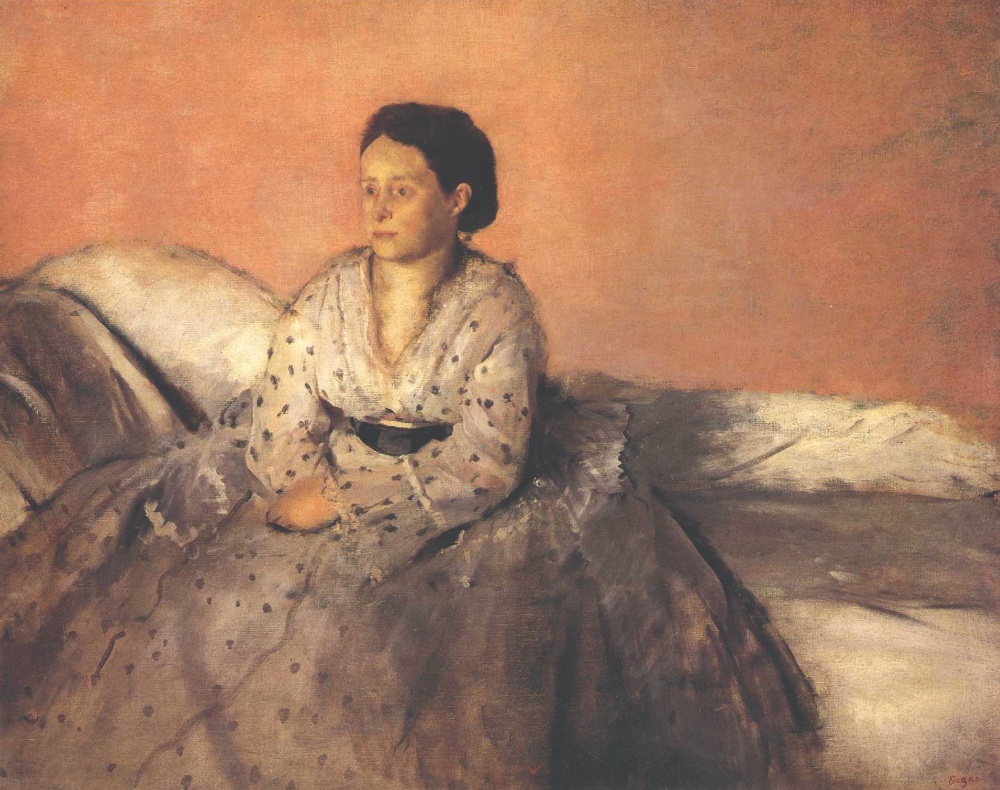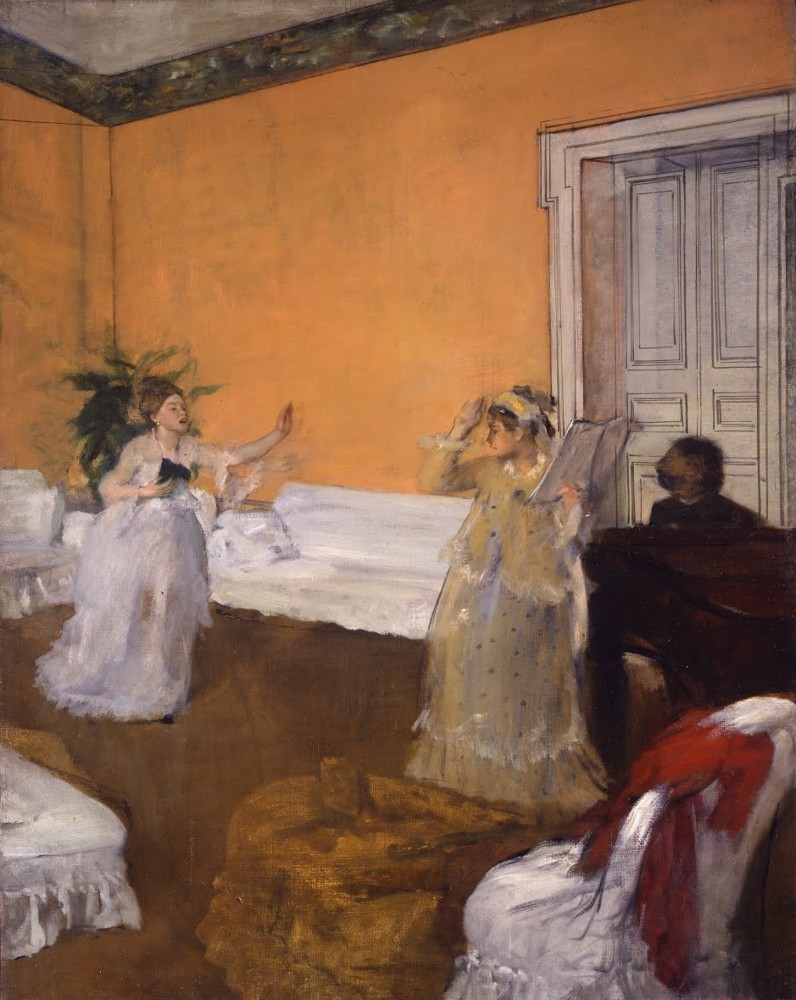Two years before shooting to fame, Edgar decided to visit his uncle and brothers in New Orleans in 1872. His mother Célestine Musson was born there, and as a child Edgar had heard many nostalgic stories of the charm and exoticism of Louisiana. Fascinated by the former French colony1 from a young age, he dreamed of one day following in the footsteps of his ancestors.
Edgar’s uncle, Michel Musson, was a prosperous businessman in New Orleans who became wealthy through the cotton trade and insurance. He socialized with both the white francophone Creoles in the French Quarter and the American colonialists in the residential and commercial areas of the city’s Garden District.
Edgar’s younger brothers, Achille and René, were born in 1838 and 1845 respectively, and had been sent to live with their uncle in America in 1865. All three worked in the family’s cotton office, and René married his first cousin Estelle in New Orleans. René spent the summer of 1872 in Paris and invited Edgar to travel back to Louisiana with him, an idea that struck a chord with the painter. He had been badly shaken by his service in the National Guard during the Prussians’ siege of Paris and the following bloody period of the Paris Commune in 1871. His professional life had grown stale, and he was still a few years from his future success; the Impressionist exhibitions in which he played a major role only began in 1874.
Wholeheartedly convinced, Edgar followed René to England and the pair set off for Louisiana in October 1872, when Degas was 38. He was warmly welcomed by his entire American family, and delighted in wandering through New Orleans, where he discovered the splendid Avenue de l’Esplanade and its luxury houses built by several generations of Creoles.
His uncle Michel owned a beautiful house with a two-story veranda in the center of a vast garden. The building was separated into private apartments and was home to the entire family De Gas2 family. Edgar stayed in his uncle’s apartment, and was even provided with a workshop for painting.
The Beauty of the Big Easy
Edgar was stunned by the beauty of New Orleans, and wrote to his friend James Tissot in Paris on November 19, 1872: “Nothing pleases me more than the Black women of all shades, holding little white babies that are oh so white in their arms, in white houses with fluted wooden columns sur- rounded by orange-trees and magnolia gardens […]. The ladies in muslin in front of their little houses and the steamboats with two smokestacks, as high as the twin chimneys of factories and the fruit merchants with shops full to overflowing. And the lovely pure-blooded ladies and the beautifully planted quadroons.”
Once Edgar Degas had rested after his travels, he settled into his daily routine, walking to his uncle’s cotton office where he read the newspapers and wrote to his associates and friends in France. His evenings were spent engaged in lively conversation with his family. René wrote in a letter in 1872 that “Edgar is so curious about New Orleans, questioning the family on their lives. He seems entirely enchanted by their southern accents and is trying to learn how to imitate them.”
Edgar painted his family’s portraits, although it sometimes irritated him. His frustration can be felt in his letters, generally written on paper bearing the De Gas Brothers letter head: “There is nothing so complex as family portraits! Sitting a cousin down while she feeds a two-month-old crying baby is most difficult! And having children pose on the front steps is twice as tiring […]. They [the portraits] must be to the family’s taste. The subjects are loving but rather brazen, and they are less inclined to take you seriously because you happen to be their nephew or cousin.”

Whatever he may have said, his family portraits are both natural and tender, painted carefully and with skill. His most frequent subjects were his first cousins, Estelle, Mathilde and Désirée Musson. The painting of his blind cousin and sister-in-law Estelle (married to his brother René) may be one of his most successful portraits. Edgar painted her just before the birth of her fourth child, to whom he was the godfather. The painting is a testament to his great modesty and reserve, and she is sat wearing a loose dress hiding her pregnant belly. Edgar manages to convincingly depict the solitude felt by his blind cousin in this softly painted portrait, her eyes open but looking away from the viewer. Her calm pose is in perfect harmony with the silvery light and repeated whites, greys and pale pinks that make up this work.
Despite the briefness of his stay, Edgar accomplished more than family portraits. As an attentive observer of life around him, he also painted a society undergoing major changes. His time in America coincided with a key moment in the history of New Orleans. The Reconstruction period started in efforts to rebuild after the horrors of the Civil War, which had severely affected the social status of Creoles.
Certain longstanding Franco-Creole families such as the Mussons continued speaking French and held on dearly to their aristocratic lifestyles, refusing to abandon their vast mansions on the Esplanade, their private opera boxes and their colored domestic staff. These families were disdainful of the influx of Anglophone immigrants, and refused to accept the rapid transformation of their city into a Southern metropolis, whose commercial port was almost as large as the port of New York.

As the enthusiasm from the beginning of his stay in Louisiana faded, Edgar languished in the state’s capital and decided to return to France in January 1873. But just before leaving he changed his mind, claiming the cotton office he frequented every day should be the subject of a naturalist painting. He extended his stay by three months, during which time he worked on different versions of the painting, which depicted merchants in top hats and their employees either idle or absorbed by work amid the cotton balls. Edgar finally returned to France in March 1873.
Although brief, Edgar’s experience in America was a decisive step in his artistic development. Upon his return he decided to definitively stop painting the historical subjects inspired by neoclassicism that were so popular in the 1860s. Instead he turned to everyday reality, following the pattern of the works he painted in New Orleans. The scenes he witnessed in the city inspired a range of remarkable paintings that are today heralded as Impressionist masterpieces.
1 New Orleans was founded in the 17th century by the French, before being ruled by Spanish colonialists for 35 years. It was once again governed by the French under Napoleon I, but was hastily sold along with the rest of Louisiana to the young United States in 1803.
2 Edgar Degas was the only member of his family to write his surname as one word. He also enjoyed mocking the “aristocratic” spelling used by the rest of his family, saying that “the nobility is not used to working. I want to work and so I will take a commoner’s name.”
Article published in the October 2015 issue of France-Amérique. Subscribe to the magazine.












